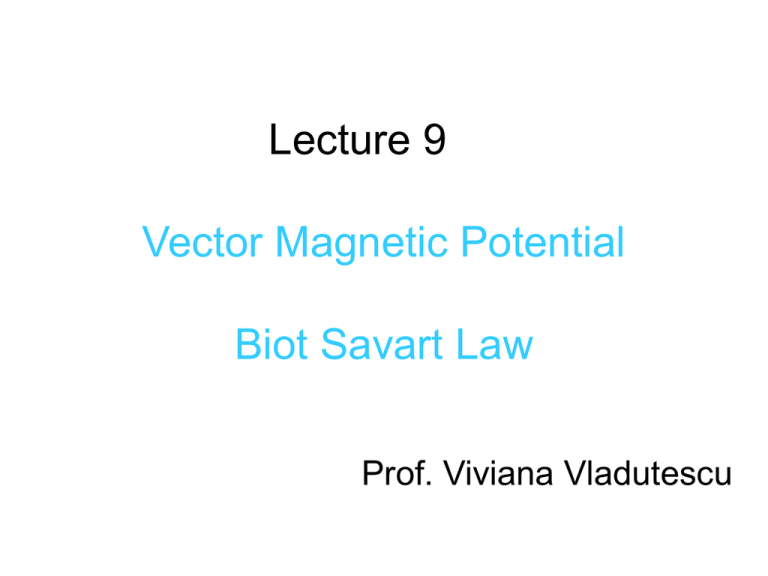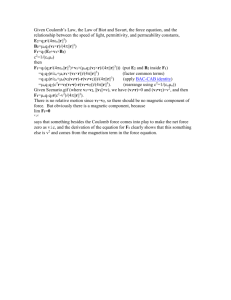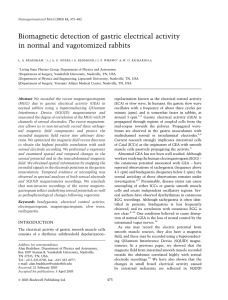Lecture 9 Vector Magnetic Potential Biot Savart Law
advertisement

Lecture 9 Vector Magnetic Potential Biot Savart Law Prof. Viviana Vladutescu Figure 1: The magnetic (H-field) streamlines inside and outside a single thick wire. Figure 2: The H-field magnitude inside and outside the thick wire with uniform current density Figure 3: The H-field magnitude inside and outside the thick conductors of a coaxial line. Vector Magnetic Potential B 0 A 0 B A (T ) A - vector magnetic potential (Wb/m) Figure 1: The vector potential in the cross-section of a wire with uniform current distribution. Figure 2: Comparison between the magnetic vector potential component of a wire with uniformly distributed current and the electric potential V of the equivalent cylinder with uniformly distributed charge. Poisson’s Equation A 0 J A ( A) ( ) A ( A) A 2 Laplacian Operator (Divergence of a gradient) ( A) A 0 J 2 2 A 0 A 0 J Vector Poisson’s equation D In electrostatics E 0 E V D E E E V V 2 Poisson’s Equation in electrostatics 1 V V dv 0 40 v R 2 0 A 0 J A 4 2 J dv v R Magnetic Flux B ds s ( A) ds A d l (Wb) s c The line integral of the vector magnetic potential A around any closed path equals the total magnetic flux passing through area enclosed by the path Biot Savart Law and Applications The Biot-Savart Law relates magnetic fields to the currents which are their sources. In a similar manner, Coulomb’s Law relates electric fields to the point charges which are their sources. Finding the magnetic field resulting from a current distribution involves the vector product, and is inherently a calculus problem when the distance from the current to the field point is continuously changing. B A (T ) 0 I d l A 4 c R dl 0 I B R 4 c f G f G f G Biot-Savart Law 0 I 1 1 B d l d l 4 c R R 1 1 By using a R 2 (see eq 6.31) R R 0 I d l aR B 2 4 c R (T) In two steps B dB c 0 I d l aR dB 2 4 R Illustration of the law of Biot–Savart showing magnetic field arising from a differential segment of current. I1d L1 a12 dH2 2 4R12 Example1 Component values for the equation to find the magnetic field intensity resulting from an infinite length line of current on the z-axis. (ex 6-4) R a R z a z r ar H Idz a z ( z a z r ar ) 4 ( z r ) 2 2 3 2 Ir a 4 (z dz 2 r ) Ir a I a z 2 2 2 H 4 r z r 2r 2 3 2 Example 2 We want to find H at height h above a ring of current centered in the x – y plane. 2 H 0 Iad a (ha z a ar ) 4 (h a ) 2 2 3 2 The component values shown for use in the Biot–Savart equation. The radial components of H cancel by symmetry. H 2 2 Ia a z 4 h a H 2 2 3 2 d 0 2 Ia a z 2 h a 2 2 3 2 Solenoid Many turns of insulated wire coiled in the shape of a cylinder. For a set N number of loops around a ferrite core, the flux generated is the same even when the loops are bunched together. Example : A simple toroid wrapped with N turns modeled by a magnetic circuit. Determine B inside the closely wound toroidal coil. a b Ampere’s Law B d l 2rB NI 0 0 NI B B a a , (b a) r (b a) 2r Electromagnets a) An iron bar attached to an electromagnet. b) The bar displaced by a differential length d. Applications Levitated trains: Maglev prototype Electromagnet supporting a bar of mass m. Wilhelm Weber (1804-1891). Electromagnetism.






